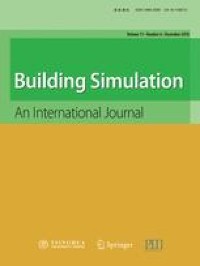Arens E, Hoyt T, Zhou X, et al. (2015). Modeling the comfort effects of short-wave solar radiation indoors. Building and Environment, 88: 3–9.
Arens E, Heinzerling D, Paliaga PE (2018). Sunlight and indoor thermal comfort. ASHRAE Journal, 2018(7): 12–21.
ASHRAE (2002). Guideline 14-2014—Measurement of Energy, Demand, and Water Savings. Atlanta: American Society of Heating, Refrigeration and Air-Conditioning Engineers.
ASHRAE (2009). ASHRAE Handbook Fundamentals. Atlanta: American Society of Heating, Refrigeration and Air-Conditioning Engineers.
ASHRAE (2017). ASHRAE-55. Thermal Environmental Conditions for Human Occupancy. Atlanta: American Society of Heating, Refrigeration and Air-Conditioning Engineers.
Bessoudo M, Tzempelikos A, Athienitis AK, et al. (2010). Indoor thermal environmental conditions near glazed facades with shading devices—Part I: Experiments and building thermal model. Building and Environment, 45: 2506–2516.
Blumthaler M (2012). Solar radiation of the high Alps. In: Lütz C (ed), Plants in Alpine Regions. Vienna: Springer.
Blumthaler M, Ambach W, Ellinger R (1997). Increase in solar UV radiation with altitude. Journal of Photochemistry and Photobiology B: Biology, 39: 130–134.
Bodach S, Lang W, Hamhaber J (2014). Climate responsive building design strategies of vernacular architecture in Nepal. Energy and Buildings, 81: 227–242.
Cappelletti F, Prada A, Romagnoni P, et al. (2014). Passive performance of glazed components in heating and cooling of an open-space office under controlled indoor thermal comfort. Building and Environment, 72: 131–144.
Chaiyapinunt S, Khamporn N (2020). Effect of solar radiation on human thermal comfort in a tropical climate. Indoor and Built Environment, https://doi.org/10.1177/1420326X19891761
Chaiyapinunt S, Phueakphongsuriya B, Mongkornsaksit K, et al. (2005). Performance rating of glass windows and glass windows with films in aspect of thermal comfort and heat transmission. Energy and Buildings, 37: 725–738.
DB54/0015-2007 (2007). Tibetan Local Standard of Heating Design for Civil Buildings. Department of Housing and Urban Rural Development of Tibet Autonomous Region, Lhasa. (in Chinese)
DB540001-2016 (2016). Design Standard for Energy Efficiency of Civil Builings in Tibet. Department of Housing and Urban Rural Development of Tibet Autonomous Region, Lhasa. (in Chinese)
De Dear RJ, Brager G (1998). Towards an adaptive model of thermal comfort and preference. ASHRAE Transactions 104(1):145–167.
Feng Y, Yang X, Zhong H (2013). Heating potential of passive solar building in Lhasa. Jounral of HV&AC, 43(6): 31–34. (in Chinese)
Gautam B, Rijal HB, Shukuya M, et al. (2019). A field investigation on the wintry thermal comfort and clothing adjustment of residents in traditional Nepalese houses. Journal of Building Engineering, 26: 100886.
Halawa E, van Hoof J, Soebarto V (2014). The impacts of the thermal radiation field on thermal comfort, energy consumption and control—A critical overview. Renewable and Sustainable Energy Reviews, 37: 907–918.
Humphreys MA, Nicol JF (1998). Understanding the adaptive approach to thermal comfort. ASHRAE Transactions 104(1): 991–1004.
Inoue T (2003). Solar shading and daylighting by means of autonomous responsive dimming glass: practical application. Energy and Buildings, 35: 463–471.
ISO 7726:1998 (1998). Ergonomics of the Thermal Environment—Instruments for Measuring Physical Quantities Ergonomie. Geneva: International Standardization Organization.
Jin H, Liu S, Kang J (2019). Thermal comfort range and influence factor of urban pedestrian streets in severe cold regions. Energy and Buildings, 198: 197–206.
Khamporn N, Chaiyapinunt S (2014). An investigation on the human thermal comfort from a glass window. Engineering Journal, 18: 25–44.
Kottek M, Grieser J, Beck C, et al. (2006). World map of the Köppen-Geiger climate classification updated. Meteorologische Zeitschrift, 15: 259–263.
Lee ES, Selkowitz SE (1995). The design and evaluation of integrated envelope and lighting control strategies for commercial buildings. Paper presented at ASHRAE Winter Meeting.
Liu Y, Jiang J, Wang D, Liu J (2018). The passive solar heating technologies in rural school buildings in cold climates in China. Journal of Building Physics, 41: 339–359.
Marino C, Nucara A, Pietrafesa M (2015). Mapping of the indoor comfort conditions considering the effect of solar radiation. Solar Energy, 113: 63–77.
Marino C, Nucara A, Pietrafesa M (2017a). Thermal comfort in indoor environment: Effect of the solar radiation on the radiant temperature asymmetry. Solar Energy, 144: 295–309.
Marino C, Nucara A, Pietrafesa M, et al. (2017b). The effect of the short wave radiation and its reflected components on the mean radiant temperature: modelling and preliminary experimental results. Journal of Building Engineering, 9: 42–51.
Milne M (2016). Climate Consultant v6.0. Available at http://www.energy-design-tools.aud.ucla.edu/
Newsham GR (1994). Manual control of window blinds and electric lighting: implications for comfort and energy consumption. Indoor and Built Environment, 3: 135–144.
Nicol F, Humphreys M, Roaf S (2010). Adaptive Thermal Comfort: Principles and Practice. London: Routledge.
Nie Q, Zhao S, Zhang Q, et al. (2019). An investigation on the climate-responsive design strategies of vernacular dwellings in Khams. Building and Environment, 161: 106248.
O’Brien W, Kapsis K, Athienitis AK (2013). Manually-operated window shade patterns in office buildings: a critical review. Building and Environment, 60: 319–338.
Pokharel TR, Rijal HB, Shukuya M (2020). A field investigation on indoor thermal environment and its associated energy use in three climatic regions in Nepal. Energy and Buildings, 222: 110073.
Singh MC, Garg SN, Jha R (2008). Different glazing systems and their impact on human thermal comfort—Indian scenario. Building and Environment, 43: 1596–1602.
Sun H, Leng M (2015). Analysis on building energy performance of Tibetan traditional dwelling in cold rural area of Gannan. Energy and Buildings, 96: 251–260.
Total Envrionment Action Inc (1980). Passive Solar Design Handbook. Washington, DC: US Department of Energy.
Wang Z (2004). Selection of themal comfort indexes in the field study. Journal of HV&AC, 34(12): 39–42. (in Chinese)
Yang L, Yan H, Xu Y, et al. (2013). Residential thermal environment in cold climates at high altitudes and building energy use implications. Energy and Buildings, 62: 139–145.
Yao J, Chow DHC, Zheng R, et al. (2016). Occupants’ impact on indoor thermal comfort: A co-simulation study on stochastic control of solar shades. Journal of Building Performance Simulation, 9: 272–287.
Yu W, Li B, Yao R, et al. (2017). A study of thermal comfort in residential buildings on the Tibetan Plateau, China. Building and Environment, 119: 71–86.
Zomorodian ZS, Tahsildoost M (2017). Assessment of window performance in classrooms by long term spatial comfort metrics. Energy and Buildings, 134: 80–93.


